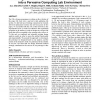Free Online Productivity Tools
i2Speak
i2Symbol
i2OCR
iTex2Img
iWeb2Print
iWeb2Shot
i2Type
iPdf2Split
iPdf2Merge
i2Bopomofo
i2Arabic
i2Style
i2Image
i2PDF
iLatex2Rtf
Sci2ools
CHI
2004
ACM
2004
ACM
Breaking the book: translating the chemistry lab book into a pervasive computing lab environment
The UK e-Science programme is relying on the evolution of the paper lab book into a pervasive data gathering lab system. To date take up of existing commercial or research lab book replacement systems has not been great. In this paper, we reconsider both the role of the lab book in the experimental cycle, as well as its affective and experiential properties as an artefact, in order to design an e-Science lab book that will be acceptable to the scientists who will use it. To this end we combined and extended existing design analysis models in order to assess the artefact functionally and experientially. We present the approach we developed, the prototype we designed based on our analysis, and the results of the formative study we performed of the artefact in real use. We show that our design elicitation method strongly contributed to the success of our prototype's take up. Author Keywords Design methods, e-Science, pervasive computing ACM Classification Keywords H.5.2 Information ...
CHI 2004 | E-Science Lab Book | Human Computer Interaction | Lab Book Replacement | Paper Lab Book |
| Added | 01 Dec 2009 |
| Updated | 01 Dec 2009 |
| Type | Conference |
| Year | 2004 |
| Where | CHI |
| Authors | Monica M. C. Schraefel, Gareth V. Hughes, Hugo R. Mills, Graham Smith, Terry R. Payne, Jeremy G. Frey |
Comments (0)

